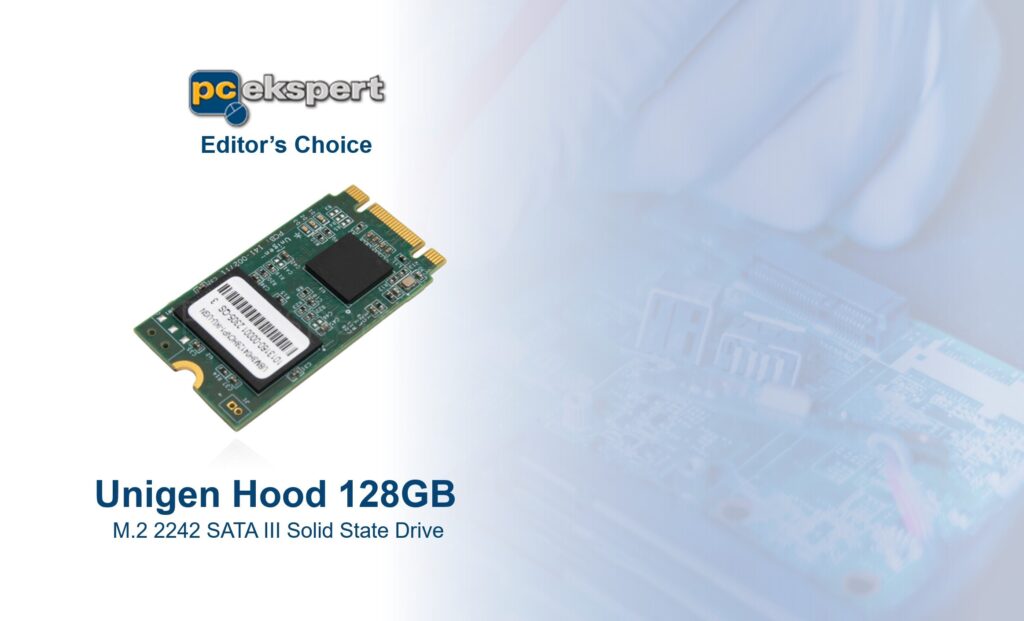Translated into English – Original article here
Hood Boot Drive SSD 128 GB
Unigen sent their “Hood” Boot Drive SSD 2242 for us to test and review. The Hood is an M.2 SATA SSD that is primarily intended for boot applications in servers and embedded devices. The test board has a capacity of 128 GB, is based on the Hyperstone X1 controller, and has TLC NAND memory converted to pSLC with high write durability.
For those who don’t know, Unigen is an American company headquartered in Newark, California (Silicon Valley), which has locations in Vietnam, China, Taiwan, and Malaysia. They have been producing industrial focused memory modules and storage solutions since 1991. They are a manufacturer of integrated electronics (EMS), from design to NPI, mass production and after-sales service. Fields of service include the automotive industry, computing and storage, embedded devices, medical, robotics and IoT.
At the beginning of the year, Unigen launched the Hood SSD M.2 2242 with a very high durability SATA III interface. It is best used for industrial applications where high durability, reliability, and low TCO (total cost of ownership) are required. Capacities of Hood range from 32 to 256 GB. We decided to test the 128 GB model. For this product, Unigen chose Hyperstone X1 SATA SSD 2-channel DRAM-less controller and paired it with BiCS5 NAND flash memory produced by Kioxia. As a reminder, Kioxia is the rebranded company of Toshiba, the inventor of NAND Flash.
The device measures only 42 x 22 x 3.5 millimeters and weighs 3 grams. It comes in capacities of 32, 64, 128 and 256 GB. Power consumption is below 1.4 W during normal operation, and below 0.2 W in idle mode. The manufacturer claims sequential performance of 375 MB/s for reads and 240 MB/s for writes, which is inline with the SATA III interface. Random 4K performance is 4,245 IOPS for reads and 3,170 IOPS for writes. MTBF is over 8.8 million hours.
The compelling feature of the Hyperstone X1 controller is that it supports Pseudo-SLC (pSLC) technology, which operates MLC or TLC NAND memory in a special mode to reduce the number of bits recoded in each cell once, allowing up to 30,000 PE cycles (program/erase). This technique increases the reliability and lifetime of NAND flash memory. In the case of Hood, Unigen uses TLC NAND memory converted to pSLC, where the 256 GB model has as much as 4 PBW of durability – yes, that’s 4 petabytes of writes. For reference, conventional desktop SSDs have below 0.6 to 0.75 PBW and capacity up to 1 TB.
The controller supports both performant AES-128 and AES-256 encryption with CBC and XTS modes (FIPS 197), has a SHA-256 hashing mechanism, a random number generator, and Secure-Boot features with TCG Opal support. It also has ECC support, up to 66 bits per 512-byte sector.
Test System & Testing Method
Test System: Hardware
- Platform: Asus Maximus Z790 Hero
- Processor: Intel Core i9 13900K
- Memory: GSkill Trident Z Royal DDR5 2x 16GB 6000 MT/s
- Graphics Card: AMD Radeon RX 7900 XT
- Sound Card: On Board
- SSD: Unigen Hood Boot SSD 128 GB
- Power Supply: SuperFlower Leadex 1200 W Platinum
- Monitor: Dell S2721DGF
Test System: Software
- OS: Windows 11 21H1
- Chipset file: AMD Chipset Driver 5.02.19.221
- DirectX version: 12
- Intel I/O Meter: 2006.07.27/1.1 Beta
- ATTO Disk Benchmark: v.4.01
- AIDA64 Engineer Edition: v6.20.5300
- AS SSD Benchmark: v2.0.7316
- Crystal Disk Mark:v8.0.1 x64
- Crystal Disk Info:v8.12.0 x64
Method of Testing
We tested the SSD on the Intel platform because only this system has an M.2 port with SATA support among the motherboards we have in the lab. We used the cooling system that comes with the motherboard, but this drive doesn’t get too hot even without it. The maximum temperature of the SSD was 49°C after a long workload while the cooling system was active. The SSD operated in SATA mode with SATA drivers of course. In addition to all the standard tests we perform, there is also a simulation of four workloads with the help of I/O Meter: Database with 67% reads and 33% writes, Workstation with 80% reads and 20% writes, Web Server with 100% reads and File Server with 80% reads and 20% writes, after which we print the number of measured IOPS.
Test Results
AS SSD and CrystalDiskMark:
Both AS SSD and Crystal use non-compressible data to measure sequential performance. Their measurements are slightly different, so we use them both for comparison. Given that it is a SATA disk, the results are solid. The purpose of this disk does not require much faster operation.
ATTO Disk Benchmark:
The ATTO test also shows similar performance, and they are more or less consistent across file sizes of 128 KB up to 64 MB
Conclusion
The Hood Boot Drive SSD is an excellent product for server and industrial applications because it provides stable performance, high reliability and high durability. All of these features are much more important than the highest performance for these target application. What matters is that the performance is consistent, which our tests have shown. The SATA interface is still widely used in the industry and solutions like this are very important. In addition to durability and reliability, the Hood also consumes little energy, which will be important in embedded applications, it does not heat up too much and is very compact.
Unigen Hood 128 GB
- Positive: High durability, compact dimensions, low power consumption, low heating, consistent performance
- Negative: Nothing of note
- Overall Evaluation: 91%
